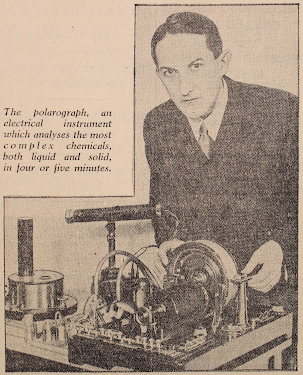CAPE TIMES - 1933, August 19
DEVICE THAT
ANALYSES LIQUORS
Revealing Chemical Contents
Whenever liquors fall under the suspicion of not being what they are claimed to be, the use of an electrical device called a polarograph, which was invented in 1922 by Prof. Jarslav Heyrovsky of Charles University, Prague, will establish beyond doubt their guilt or innocence.
The Polarograph automatically analyses all kinds of liquids and solids, including the most complex chemical solutions, and thus saves hours of tedious work in laboratories. The solution to be analyzed is placed in a small container, in which it is electrolytically decomposed. Then by closing an electric switch the device automatically records on a strip of paper wound on a drum a graph in the form of a curved line which indicates both the relationship between the current passing through the solution and the magnitude of the electromotive force.
.png)
Prof.
Heyrovsky says that the use of the polarograph makes it possible for the
investigator to analyze both qualitatively and quantitatively the numerous
complex alcohols as well as the still more complicated compounds of which the
lowest forms of life are composed.
“The polarograph method in the determination of substances occurring in almost imperceptible traces,” Prof. Heyrovsky explains, “is more than 1 000 times as sensitive as X-ray spectrum analysis.
The presence of so infinitesimal a
quantity as one ten-thousandth of a part of many substances, though not all,
may be detected.
“This
instrument also may be used in research laboratories in physics, chemistry, biology,
in clinics, medical laboratories, laboratories of the petroleum and other
industries, and in pharmaceutical research. In industry it can be used in the
study of fermentation processes, for the determination of the quality of
molasses and of various sugar, and in the study of ores and alloys, rocks,
waters, gases, minerals and meteorites.”
Read more about the POLAROGRAPH at https://www.britannica.com/science/polarography
.png)




No comments:
Post a Comment